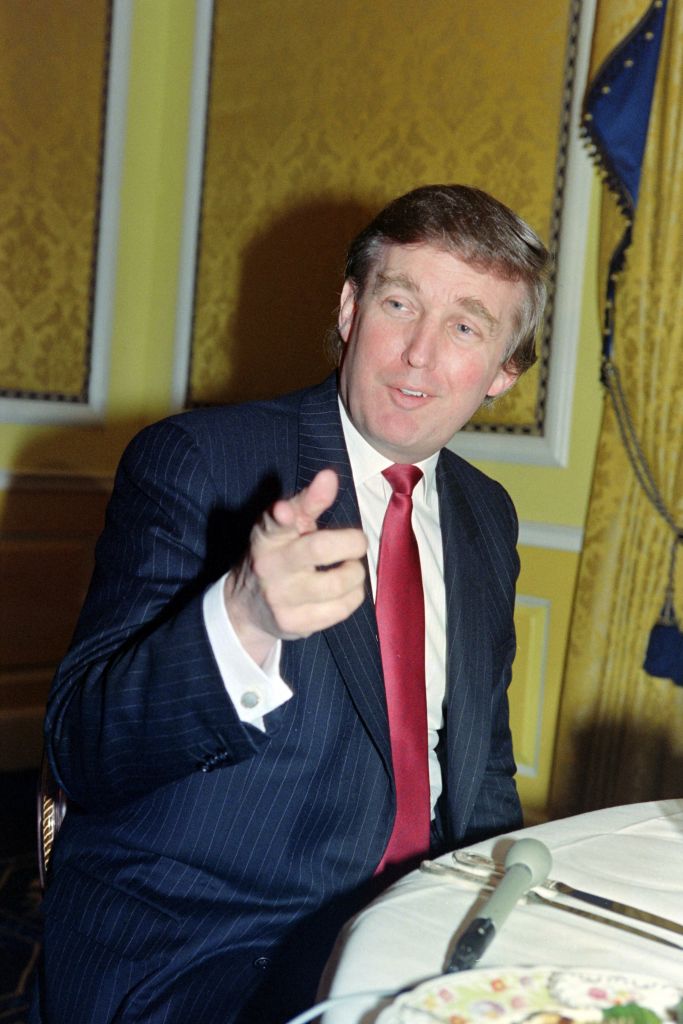
Donald Trump answers questions from reporters about his divorce from wife Ivana at a news conference in New York on Dec. 11, 1990. (Timothy A. Clary/AFP/Getty Images)
Ever since Donald Trump threw his hat into the presidential ring he has been able to monopolize media attention at will. With one outrageous comment after another he pulls the spotlight back to himself, dominating headlines and getting more than 30 percent more media coverage than all the other candidates. Call him a masterful politician, a marketing genius, a reality show star, a narcissist, a demagogue or a huckster. He is all those. What he is not, however, is a self-made, successful, businessman.
Buried beneath the breathless coverage is some significant investigative journalism — both new and old — filled with facts. There is even a rarely viewed 25-year-old documentary that serves as a glitzy time capsule filled with archival footage of The Donald — and more pesky facts. It remains to be seen whether these facts can outpace the fiction in the 2016 race. We look forward to sharing more investigations on more topics. As Walter Lippmann wrote, “There can be no higher law in journalism than to tell the truth and to shame the devil.”
— Wayne Barrett and Jon Campbell, The Village Voice
Wayne Barrett, author of a Donald Trump biography, is an investigative reporter who dogged Trump for almost 40 years. His two-part series, the first installment of which was co-written with Jon Campbell, was first published in The Village Voice in 1979, and republished last summer. The portrait of Trump painted by Barrett in these pieces is that of a son getting ahead thanks to his father’s financial credit and longtime political cronyism.
- Part 1: How a Young Donald Trump Forced His Way From Avenue Z to Manhattan, The Village Voice
- Part 2: Behind the ’70s-Era Deals That Made Donald Trump, The Village Voice
— Susanne Craig and David Chen, The New York Times
The New York Times published several investigative pieces this week. Susanne Craig and David Chen dig into Trump’s business dealings in New York City and reveal that major banks are leery of lending to him after losing millions in the past. Lawyers and contractors have also been burnt by slow payments and shortchanging. In another article, Charles Bagli and Megan Twohey expose hiring practices at Mar-a-Lago Club in Palm Beach, Florida: Trump relies on imported labor in his luxury even while promising on the campaign trail Trump to protect American jobs. Since 2010, only 17 out of 300 US residents who applied for jobs at the hotel were hired. During the same period, hotel management pursued more than 500 visas for foreign workers. Sponsored foreign workers are unable to work elsewhere and become, essentially, a captive workforce.
Last summer a Reuters analysis of US government data showed that the hiring practices are business as usual at nine companies majority-owned by Trump. Since 2000, these companies applied for at least 1,100 foreign workers on temporary visas. Most applications were approved and foreign workers were chosen over Americans for positions including waitresses, cooks, vineyard workers, models and golf course workers.
- Donald Trump in New York: Deep Roots, but Little Influence, The New York Times
- Donald Trump to Foreign Workers for Florida Club: You’re Hired, The New York Times
- Trump University’s Checkered Past Haunting Candidate, The New York Times
- Exclusive: Donald Trump’s companies have sought visas to import at least 1,100 workers, Reuters
Last fall and over the winter, Robert O’Harrow and his colleagues in the investigative unit at The Washington Post detailed the hardball tactics Trump learned in business and in the courts. They document a federal lawsuit brought against Trump’s real estate management firm in 1973 for racial discrimination that violated the Fair Housing Act; they reveal Trump’s dealings with the Democratic machine and organized crime to get ahead in the 1970s; and they disclose how he leveraged his casino into bankruptcy in the 1990s.
- Inside the government’s racial bias case against Donald Trump’s company, and how he fought it, The Washington Post
- Trump’s bad bet: How too much debt drove his biggest casino aground, The Washington Post
- Trump swam in mob-infested waters in early years as an NYC developer, The Washington Post
— David Cay Johnston, The National Memo
David Cay Johnston is a Pulitzer Prize-winning former New York Times reporter who writes about economics and has been reporting on Donald Trump since 1988. He wrote about Trump’s net worth and exploits in the gambling industry in his 1992 book, Temples of Chance. After Trump announced his candidacy last summer, Cay Johnston came up with a list of questions he would like Trump to answer.
- 21 Questions For Donald Trump, The National Memo
- Donald Trump’s Business Record Demands More Scrutiny, The New Yorker
Trump: What’s the deal? is a period piece produced in the late 1980s. The documentary is an unflattering look at Trump’s mafia connections and legal troubles as he rose to prominence. It was backed by Leonard Stern who owned The Village Voice and Seven Days magazine, and looking to expand into television with a series on celebrity businessmen. When Trump learned about the film, he threatened to sue anyone who broadcast or distributed it. A personal fight between Stern and Trump broke out and Stern pulled the plug. Producers Ned Schnurman and Libby Handros and director Al Levin eventually finished the film, but it was screened in public only once in 1991, and then shelved. Last summer, Libby Handros dusted it off, digitized it and uploaded it to the internet.




